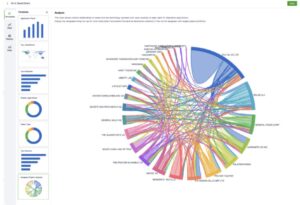Harnessing the power of artificial intelligence (AI) and crowdsourcing in the context of patents and intellectual property (IP) offers innovative approaches to streamline IP management and IP research processes, enhance accuracy, and democratise IP management, research and creation. The benefits are wide ranging. Both AI and crowdsourcing can significantly reduce the time and cost associated with patent searches, drafting, and management, thus increasing efficiency. AI can enhance the precision of searches and analysis, while crowdsourcing can provide additional validation and insights. Crowdsourcing also opens up new avenues for innovation by tapping into a diverse pool of ideas and expertise. Here’s a look at how these technologies are applied.
Artificial Intelligence in Patents and Intellectual Property
Patent Search and Analysis

AI applies machine learning and natural language processing to quickly understand the invention technology in a patent. Source: PatSnap
AI can classify patents into different categories, aiding in better organization and retrieval. Machine learning algorithms can analyse vast databases of existing patents to help identify prior art, which is crucial for determining the novelty of an invention. Natural Language Processing (NLP) can interpret and understand complex technical documents, enabling more effective searches for similar patents or relevant literature.
Patent Drafting and Examination
AI tools can assist in drafting patent applications by generating descriptions, claims, and diagrams based on input data about the invention. AI can also identify inconsistencies and potential errors in patent documents, improving the quality of submissions, plus automate the process of examining prior art to assess the novelty and non-obviousness of an invention. “Prior art” refers to any evidence that an invention is already known.
IP Management
AI can help in managing large portfolios of existing patents, identifying underutilised assets, and suggesting potential licensing opportunities. AI can also predict the potential success and enforceability of a new patent, based on historical data and trends.
Crowdsourcing in Patents and Intellectual Property
Idea generation and Innovation
Companies can use open innovation crowdsourcing platforms to gather ideas and other input from a large pool of contributors, leading to more diverse and creative solutions.
Some of the platforms allow tighter groups of perhaps specifically invited inventors and experts to collaborate remotely on developing new technologies and products.
Prior Art Search and Verification
Crowdsourcing can be used to conduct thorough prior art searches, leveraging the collective knowledge of a large group of people to uncover relevant documents that might be missed by traditional searches.
The general public, or specific communities, can review and provide feedback on pending patent applications, helping to identify prior art and assess the validity of claims.
Patent Challenges and Defence
Crowdsourcing can help in challenging the validity of granted patents by inviting experts to identify prior art or other grounds for invalidation.
Additionally, crowdsourcing can support the creation of patent pools where multiple stakeholders contribute patents to a shared pool, facilitating licensing and reducing litigation risks.
Integration of AI and Crowdsourcing
The combination of AI and crowdsourcing can create a synergistic effect, enhancing the strengths of each approach.
AI can pre-process and filter vast amounts of data, making crowdsourced searches more focused and effective. AI can analyse and validate the contributions from crowdsourced participants, ensuring higher quality and relevance of the information gathered.
The integration allows for handling large-scale projects by leveraging AI’s processing power and the extensive reach of crowdsourcing.
However, some challenges remain. Principally, AI cannot replace human creativity. Crowdsourcing platforms can connect inventors with a global pool of crowdsourced experts (scientists, engineers, lawyers) to refine ideas, identify potential applications and validate inventions.
Furthermore, managing sensitive information and ensuring the privacy and security of data is critical. Ensuring the quality and reliability of crowdsourced inputs can also be challenging. AI systems must be designed to avoid biases, and crowdsourcing should be managed to ensure fair representation and contribution.
5 leading platforms in this sector
Here are five well-regarded options that leverage AI to deliver patent and IP research and management-related services.
PatSnap
PatSnap is an innovation intelligence platform that uses AI to provide comprehensive patent search and analysis tools. It is designed to help organizations understand the competitive landscape, identify emerging trends, and make informed R&D decisions.
Key features include advanced search capabilities with AI-driven insights. It analyses patents, scientific papers, and company data on a global basis, and identifies technology trends and innovation hotspots. PatSnap also facilitates collaboration among R&D teams, and is particularly useful for IP professionals and more general business strategists looking to gain competitive insights and manage their patent portfolios efficiently.
IP.com
IP.com provides intellectual property solutions that combine AI and big data analytics to support patent search, analysis, and management. It is beneficial for patent attorneys, researchers, and innovation managers who need robust tools for prior art searches.
It has access to a comprehensive database of patents and non-patent literature, with enhanced search capabilities using natural language processing. It can provide insights into competitors’ IP strategies and activities, plus in-depth analysis and visualization of patent landscapes.
RightHub
RightHub is an emerging platform in the patents and intellectual property sector that offers integrated services for managing IP assets. It provides a suite of tools that cover the entire lifecycle of IP assets, from creation and filing to enforcement and monetization, and leverages AI technology to streamline and optimize the IP management process. The senior management team is a blend of experienced Intellectual Property professionals: patent attorneys, software entrepreneurs, administrators, and design and development gurus who have run and sold successful businesses.
The platform supports IP filings in multiple jurisdictions, ensuring compliance with local laws and regulations. However, like any comprehensive platform, there might be a learning curve associated with its adoption. It is far from alone in this aspect, and adequate training and support are necessary to maximize the benefits of each of the listed platforms.
PatSeer
PatSeer is an Indian AI-driven B2B SaaS platform for Intellectual Property (IP) research and intelligence. It’s a hybrid combination of AI-driven tech and experts, and its set of filters, charts, and analytic tools help users generate actionable insights with ease and confidence. PatSeer is trusted by leading law firms, KPOs, technology startups, and major corporations across 38+ countries.
Anaqua
Anaqua delivers complete Intellectual Property software and services solutions, tailored to users’ specific needs. Anaqua’s AQX platform combines best practice workflows with big data analytics and tech-enabled services to create an intelligent environment designed to inform IP strategy, enable IP decision-making, and streamline IP operations. Today, nearly half of the top 100 U.S. patent filers and global brands, as well as a growing number of law firms worldwide, use Anaqua’s solutions. It is headquartered in Boston, with offices across the U.S., Europe, and Asia.
Key Takeaways
Overall, the combination of artificial intelligence and crowdsourcing holds significant potential for transforming the landscape of patents and intellectual property, offering more efficient, accurate, and inclusive methods for innovation and IP research and management.
The listed platforms exemplify how AI, sometimes alongside crowdsourcing, can be leveraged to enhance various aspects of patents and intellectual property management, from idea generation and prior art search to competitive intelligence and innovation strategy.




0 Comments